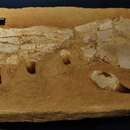zh-TW
在導航的名稱


The Mosasaurinae are a subfamily of mosasaurs, a diverse group of Late Cretaceous marine squamates. Members of the subfamily are informally and collectively known as "mosasaurines" and their fossils have been recovered from every continent except for South America.[3]
The lineage first appears in the Turonian and thrived until the K-Pg mass extinction at the end of the Maastrichtian. They ranged in size from some of the smallest known mosasaurs (Carinodens, 3–3.5 meters), to medium-sized taxa (Clidastes, 6+ meters), to the largest of the mosasaurs (Mosasaurus hoffmannii) potentially reaching about 13 m in length. Many genera of mosasaurines were either piscivorous or generalists, preying on fish and other marine reptiles, but one lineage, the Globidensini, evolved specialized crushing teeth, adapting to a diet of ammonites and/or marine turtles.
Though represented by relatively small forms throughout the Turonian and Santonian, such as Clidastes, the lineage diversified during the Campanian and had by the Maastrichtian grown into the most diverse and species-rich mosasaur subfamily.[4]
The etymology of the group derives from the genus Mosasaurus (Latin Mosa = "Meuse river" + Greek sauros = "lizard").
Russell (1967, pp. 123–124)[5] defined the Mosasaurinae as differing from all other mosasaurs as follows: "Small rostrum present or absent anterior to premaxillary teeth. Fourteen or more teeth present in dentary and maxilla. Cranial nerves X, XI, and XII leave lateral wall of opisthotic through two foramina. No canal or groove in floor of basioccipital or basisphenoid for basilar artery. Suprastapedial process of quadrate distally expanded. Dorsal edge of surangular thin lamina of bone rising anteriorly to posterior surface of coronoid...At least 31, usually 42–45 presacral vertebrae present. Length of presacral series exceeds that of postsacral, neural spines of posterior caudal vertebrae elongated to form distinct fin. Appendicular elements with smoothly finished articular surfaces, tarsus and carpus well ossified." In his 1997 revision of the phylogeny of the Mosasauroidea, Bell (pp. 293–332) retained the Mosasaurinae as a clade, though he reassigned Russell's tribe Prognathodontini to the Mosasaurinae and recognized a new tribe of mosasaurines, the Globidensini.[6][7]
The subfamily is generally recognised as containing two subdivisions, the tribes Globidensini (Globidens and its closest relatives) and Mosasaurini (Mosasaurus and its closest relatives). A third tribe, the Prognathodontini (Prognathodon and its closest relatives, such as Plesiotylosaurus), is also used on occasion.[5] "Clidastini" or the adjective "clidastine" is also used sometimes, but generally refers to an adaptive grade close to and containing the genus Clidastes, rather than an actual clade.[8]
Cladogram of the Mosasaurinae modified from Longrich et al., 2022:[9]
Mosasaurinae GlobidensiniGlobidens simplex
Globidens schumani
Globidens phosphaticus
Prognathodon rapax (=Ancylocentrum hungerfordi)
Globidens alambamensis
Globidens dakotensis
PrognathodontiniPrognathodon overtoni
Prognathodon saturator
Thalassotitan atrox
Prognathodon currii
Prognathodon giganteus
Prognathodon lutugini
Prognathodon solvayi
MosasauriniMosasaurus mokoroa
Mosasaurus conodon
Mosasaurus missouriensis
Mosasaurus lemonnieri
Mosasaurus hoffmannii
Mosasaurus beaugei
Mosasaurus maximus
Mosasaurus sp. (MGGC 21876)
"Magahouanga mosasaurine"
The Mosasaurinae are a subfamily of mosasaurs, a diverse group of Late Cretaceous marine squamates. Members of the subfamily are informally and collectively known as "mosasaurines" and their fossils have been recovered from every continent except for South America.
The lineage first appears in the Turonian and thrived until the K-Pg mass extinction at the end of the Maastrichtian. They ranged in size from some of the smallest known mosasaurs (Carinodens, 3–3.5 meters), to medium-sized taxa (Clidastes, 6+ meters), to the largest of the mosasaurs (Mosasaurus hoffmannii) potentially reaching about 13 m in length. Many genera of mosasaurines were either piscivorous or generalists, preying on fish and other marine reptiles, but one lineage, the Globidensini, evolved specialized crushing teeth, adapting to a diet of ammonites and/or marine turtles.
Though represented by relatively small forms throughout the Turonian and Santonian, such as Clidastes, the lineage diversified during the Campanian and had by the Maastrichtian grown into the most diverse and species-rich mosasaur subfamily.
The etymology of the group derives from the genus Mosasaurus (Latin Mosa = "Meuse river" + Greek sauros = "lizard").
Les Mosasaurinae sont une sous-famille éteintes de reptiles marins appartenant à la famille également éteintes des mosasauridés et ayant existé au Crétacé supérieur, il y entre 92 et 66 millions d'années. Les membres de la sous-famille sont connus de manière informelle sous le nom de mosasaurinés et ont été retrouvés sur tous les continents, à l'exception de l'Amérique du Sud[1].
La lignée apparaît pour la première fois dans le Turonien et a prospéré jusqu'à l'événement d'extinction de masse à la fin du Maastrichtien. Leur taille variait de quelques-uns des plus petits mosasaures connus (Carinodens, dans les 3 à 3,5 mètres), à des taxons de taille moyenne (Clidastes, dans les 6 mètres), au plus grand mosasaures (Mosasaurus hoffmannii) pouvant atteindre 17 m de long. De nombreux genres de mosasaurinés étaient soit piscivores, soit généralistes, s'attaquant au poisson et à d'autres reptiles marins, mais une lignée, les Globidensini, avait développé une technique de concassage des dents spécialisée, adaptée à un régime alimentaire composé d'ammonites ou de tortues marines de grande taille (Protostegidae) comme Archelon voir de dinosaures.
Bien que représentée par des formes relativement petites sur l'ensemble du Turonien et du Santonien, telles que Clidastes, la lignée s'est diversifiée au cours de la période campanienne et, par la suite du Maastrichtien, est devenue la sous-famille de Mosasauroidea la plus diverse et la plus riche en espèces[2].
Les Mosasaurinae sont une sous-famille éteintes de reptiles marins appartenant à la famille également éteintes des mosasauridés et ayant existé au Crétacé supérieur, il y entre 92 et 66 millions d'années. Les membres de la sous-famille sont connus de manière informelle sous le nom de mosasaurinés et ont été retrouvés sur tous les continents, à l'exception de l'Amérique du Sud.